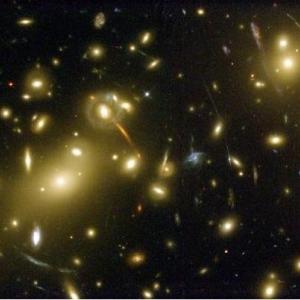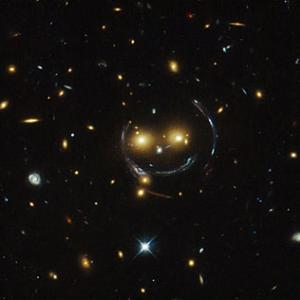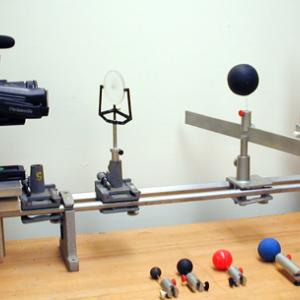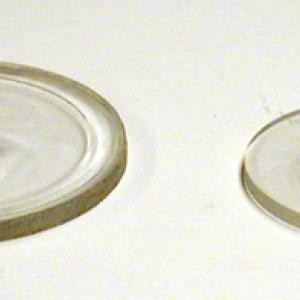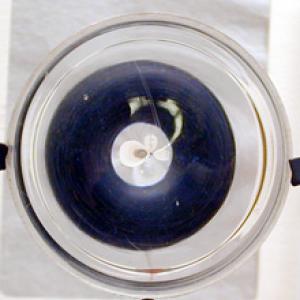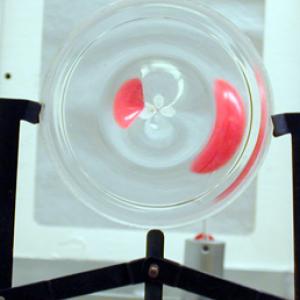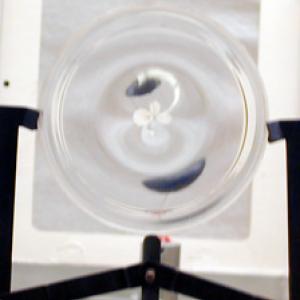College of Liberal Arts & Sciences
8C20.40 - Gravitational Lens
Focus the camera so that it is only looking at an area that is the size of the lens. Put the stand with the ball on the slider rail and as you slide it across into the field of view of the lens you should see arcs and/or full circles (donut shaped images).
- Jun Su, Weiguo Wang, Xu Wang, and Feng Song, "Simulation of the Gravitational Lensing Effect of Galactic Dark Matter Halos Using 3D Printing Technology", TPT, Vol. 57, #9, Dec. 2019, p. 590.
- Jes Ford, Jared Stang, and Catherine Anderson, "Simulating Gravity: Dark Matter and Gravitational Lensing in the Classroom", TPT, Vol. 53, #9, Dec. 2015, p. 557.
- Paul Huwe and Scott Field, "Modern Gravitational Lens Cosmology for Introductory Physics and Astronomy Students", TPT, Vol. 53, #5, May 2015, p. 266.
- Joseph Roy D. North, "Figuring Physics Indeed!", TPT, Vol. 39, #4, Apr. 2001, p. 198.
- Paul Hewitt, "Figuring Physics: Gravitational Lens", TPT, Vol. 38, #9, Dec. 2000, p. 524.
- Maria Falbo-Kenkel and Joe Lohre, "Simple Gravitational Lens Demonstrations", TPT, Vol. 34, #9, Dec. 1996, p. 555.
- P. J. Ouseph, "How Many Fish Are in the Tank? A Demonstration of Refraction Light", TPT, Vol. 25, #7, Oct. 1987, p. 440.
- Bogdan Szafraniec, James F. Harford, "A Simple Model of a Gravitational Lens from Geometric Optics", AJP, Vol. 92, #11, Nov. 2024, p. 878.
- Brett C. George, Eleni-Alexandra Kontou, Patrycja Przewoznik, et al, "An Exploration of Circumbinary Systems Using Gravitational Microlensing", AJP, Vol. 91, #3, March 2023, p. 182.
- Stefan Catheline, Victor Delattre, Gabrielle Laloy-Borgna, et al., "Gravitational Lens Effect Revisited Through Membrane Waves", AJP, Vol. 90, #1, Jan. 2022, p. 47.
- Sanjoy Mahajan, "Bending of Starlight by Gravity", AJP, Vol. 89, #8, Aug. 2021, p. 749.
- Markus Selmke, "An Optical n-Body Gravitational Lens Analogy", AJP, Vol. 89, #1, Jan. 2021, p. 11.
- Tommaso Treu, Philip J. Marhsall, and Douglas Clowe, "Recourse Letter GL-1: Gravitation Lensing", AJP, Vol. 80, #9, Sep. 2012, p. 753.
- Rafael Ferraro, "The Equivalence Principle and the Bending of Light", AJP, Vol. 71, #2, Feb. 2003, p. 168.
- Alex Alaniz, "A Simple Special Relativistic Perturbation Scheme for Yielding the General Relativistic Behavior of Point Particles and Photons in the Gravitational Field of Stars", AJP, Vol. 70, #5, May 2002, p. 498.
- Francisco Frutos Alfaro, "A Computer Program to Visualize Gravitational Lenses", AJP, Vol. 69, #2, Feb. 2001, p. 218.
- M. J. Nandor and T. M. Helliwell, "Fermat's Principle and Multiple Imaging by Gravitational Lenses", AJP, Vol. 64, #1, Jan. 1996, p. 45.
- Ronald J. Adler, William C. Barber, and Mark E. Redar, "Gravitational Lenses and Plastic Simulators", AJP, Vol. 63, #6, June 1995, p. 536.
- Clifford M. Will, "Henry Cavendish, Johann von Soldner, and the Deflection of Light", AJP, Vol. 56, #5, May 1988, p. 413.
- James G. Ellingson, "The Deflection of Light by the Sun Due to Three-Space Curvature", AJP, Vol. 55, #8, Aug.1987, p. 759.
- Hans C. Ohanian, "The Black Hole as a Gravitational 'Lens'", AJP, Vol. 55, #5, May 1987, p. 428.
- Joachim Schastok, Michael Soffel, Hanns Ruder, and Manfred Schneider, "Stellar Sky As Seen from the Vicinity of a Black Hole", AJP, Vol. 55, #4, Apr. 1987, p. 336.
- Jack Higbie, "Galactic Lens", AJP, Vol. 51, #9, Sep. 1983, p. 860.
- J. Higbie, "Gravitational Lens", AJP, Vol. 49, #7, July 1981, p. 652.
- Vincent Icke, "Construction of a Gravitational Lens", AJP, Vol. 48, #10, Oct. 1980, p. 883.
- Robert P. Comer and John D. Lathrop, "Principle of Equivalence and the Deflection of Light by the Sun", AJP, Vol. 46, #8, Aug. 1978, p. 801.
- Sidney Liebes, Jr., "Gravitational Lens Simulator", AJP, Vol. 37, #1, Jan. 1969, p. 103.
- Sebastian Fernandez-Mulligan, "Learning to See Gravitational Lenses", Physics Today, Vol. 78, #3, March 2025, p. 31.
- Johanna Miller, "Gravitational-Lensing Measurements Push Hubble-Constant Discrepancy Past 5 Sigma", Physics Today, Vol. 73, #3, March 2020, p. 14.
- Steven K. Blau, "A Gravitational-Lensing Measurement of the Hubble Constant", Physics Today, Vol. 70, #4, Apr. 2017, p. 24.
- Steven K. Blau, "Remarkable Gravitational Lensing by the Galaxy Cluster Avell 3827", Physics Today, Vol. 68, #6, June 2015, p. 18.
- "Mapping the Mass of a Galaxy Cluster", Physics Today, Vol. 67, #9, Sept. 2014, p. 72.
- Bertram Schwarzschild, "Microlensing Suggests that Our Galaxy Has More Planets Than Stars", Physics Today, Vol. 65, #3, Mar. 2012, p. 19.
- Johanna L. Miller, "High-Resolution Data Demonstrate Gravitational Lensing of the Cosmic Microwave Background", Physics Today, Vol. 64, #8, Aug. 2011, p. 14.
- Bertram Schwarzschild, "Gravitational Microlensing Reveals the Lightest Exoplanet Yet Found", Physics Today, Vol. 59, #4, Apr. 2006, p. 22.
- Leon V. E. Koopmans and Roger D. Blandford, "Gravitational Lenses", Physics Today, Vol. 57, #6, June 2004, p. 45.
- Thomas E. Collett, Lindsay J. Oldham, Russell J. Smith, Matthew W. Auger, Kyle B. Westfall, David Bacon, Robert C. Nichol, Karen L. Masters, Kazuya Koyama, and Remco van den Bosch, "A Precise Extragalactic Test of General Relativity", Science, Vol. 360, #6395, June 2018, p. 1342.
- J. Richard Gott III, "Gravitational Lenses: Cosmic Mirages Produced by Gravitational Bending of Light May Solve Some of the Most Pressing Problems in Cosmology Today", American Scientist, Vol. 71, #2, March-April 1983, p. 150.
- "Research News: Editors Choice: Gravity Lens Produces Four Images of Stellar Explosion", APS News, Vol. 26, #6, June 2017, p. 1, 7.
- Isaac Asimov, "The Cosmic Lens", Fantasy and Science Magazine, p. 114 - 123.
- John G. Cramer, "The Rainbows of Gravity", Analog Science Fiction/Science Fact Magazine, p. 117 - 121.
Disclaimer: These demonstrations are provided only for illustrative use by persons affiliated with The University of Iowa and only under the direction of a trained instructor or physicist. The University of Iowa is not responsible for demonstrations performed by those using their own equipment or who choose to use this reference material for their own purpose. The demonstrations included here are within the public domain and can be found in materials contained in libraries, bookstores, and through electronic sources. Performing all or any portion of any of these demonstrations, with or without revisions not depicted here entails inherent risks. These risks include, without limitation, bodily injury (and possibly death), including risks to health that may be temporary or permanent and that may exacerbate a pre-existing medical condition; and property loss or damage. Anyone performing any part of these demonstrations, even with revisions, knowingly and voluntarily assumes all risks associated with them.
